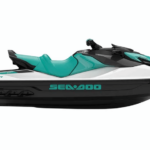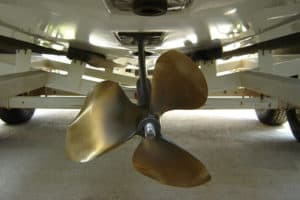Winterizing a jet ski is an important process that should be done before storing it away for the winter season.
Failure to properly winterize a jet ski can result in engine damage, corrosion, and other costly repairs.
In this article, we will provide a step-by-step guide on how to winterize a jet ski to ensure it is ready to hit the water when the warmer weather returns.
The first step in winterizing a jet ski is to remove it from the water and secure it on a trailer. Once the jet ski is out of the water, it’s time to start the winterizing process.
This includes draining the fuel system, flushing the jet ski with a mixture of RV and water, and lubricating the metal and moving parts.
It’s also important to properly store the jet ski in a secure location to prevent any damage from the winter weather.
By following these steps, jet ski owners can ensure their watercraft is properly winterized and ready to go when the weather warms up.
Whether you’re a seasoned jet ski owner or a first-time buyer, it’s important to take the time to properly winterize your jet ski to avoid any costly repairs and ensure a fun and safe experience on the water.
Preparing Your Jet Ski for Winterization

Before winterizing your jet ski, it is important to prepare it properly. This will help ensure that your watercraft is ready for storage and will be in good condition when you are ready to use it again.
Cleaning the Exterior
The first step in preparing your jet ski for winterization is to clean the exterior. Use a mild detergent and water to wash away any dirt, algae, or sand that may have accumulated on the surface. Rinse thoroughly to remove any soap residue, and dry with a soft cloth.
Draining Water from the Engine and Exhaust System
The next step is to drain water from the engine and exhaust system. This is important because any water left in the system can freeze and cause damage during the winter. To do this, remove the drain plugs and allow the water to drain completely. Refer to your owner’s manual for specific instructions on how to do this.
Inspecting for Damage and Wear
Finally, inspect your jet ski for any damage or wear that may need to be addressed before winter storage. Check the hull for cracks or other damage, and inspect the propeller for any signs of wear. If you notice any issues, be sure to address them before storing your watercraft for the winter.
By following these steps, you can ensure that your jet ski is properly prepared for winterization. This will help protect your watercraft and ensure that it is ready for use when the weather warms up again.
Internal Maintenance

Winterizing a jet ski requires a few internal maintenance steps to ensure that it is ready to go when the next season rolls around. Here are a few essential internal maintenance tasks:
Changing Oil and Filter
Changing the oil and filter is an important part of winterizing a jet ski. Old oil can become acidic and cause damage to the engine, so it is important to change the oil and filter before storing the jet ski for the winter. Make sure to use the correct type of oil and filter recommended by the manufacturer.
Adding Fuel Stabilizer and Draining the Carburetor
Adding fuel stabilizer to the gas tank and draining the carburetor can help prevent the fuel system from clogging and causing damage to the engine. Fuel stabilizer helps to prevent the gas from breaking down and causing damage to the fuel system. Draining the carburetor helps to remove any excess gas from the system, preventing it from clogging.
Lubricating Moving Parts and Applying Fogging Oil
Lubricating the moving parts and applying fogging oil can help prevent corrosion and damage to the internal components of the jet ski. Lubricate all moving parts, including the throttle, steering cables, and fuel lines. Applying fogging oil to the cylinder and spark plugs can help protect them from rust and corrosion.
By following these internal maintenance steps, jet ski owners can help ensure that their jet ski is ready to go when the next season arrives. It is important to follow the manufacturer’s recommendations for maintenance and to store the jet ski in a dry, secure location.
Protecting the Fuel System
To ensure that your jet ski is ready to ride again when the weather warms up, it’s important to properly protect the fuel system during the winterization process. This involves filling the gas tank and using antifreeze in the cooling system.
Filling the Gas Tank
Before storing your jet ski for the winter, it’s important to fill the gas tank to prevent moisture from accumulating inside. Moisture can cause rust and corrosion in the fuel tank, which can lead to costly repairs in the spring.
In addition to filling the tank, it’s also recommended to add a fuel stabilizer. This will help prevent the gas from breaking down and becoming stale over the winter months. Simply add the stabilizer to the gas tank and run the engine for a few minutes to ensure that the mixture is evenly distributed throughout the fuel system.
Using Antifreeze in the Cooling System
Another important step in winterizing your jet ski is to use antifreeze in the cooling system. This will help prevent any remaining water from freezing and causing damage to the engine and other components.
To use antifreeze in the cooling system, first drain all of the water from the system by running the engine for a few minutes with the water intake hose removed. Then, fill the system with a 50/50 mixture of RV antifreeze and water. Be sure to run the engine for a few minutes to ensure that the mixture is evenly distributed throughout the cooling system.
By properly protecting the fuel system, you can ensure that your jet ski is ready to ride again when the weather warms up.
Electrical System Care

Proper care of the electrical system is essential to ensure that your jet ski starts up smoothly in the spring. In this section, we will cover how to charge and disconnect the battery.
Charging and Disconnecting the Battery
Before storing your jet ski for the winter, it’s important to remove the battery and store it in a cool, dry place. This will help prevent the battery from freezing or corroding over the winter months.
To remove the battery, start by turning off the jet ski and disconnecting the negative (-) cable, followed by the positive (+) cable. Then, remove any brackets or straps holding the battery in place and carefully lift it out of the battery compartment.
Once the battery is removed, it’s a good idea to charge it fully before storing it. This can be done using a trickle charger or battery maintainer. These devices are designed to charge the battery slowly over a long period of time, which helps to maintain the battery’s overall health and prolong its lifespan.
When using a trickle charger or battery maintainer, be sure to follow the manufacturer’s instructions carefully. Generally, you will need to connect the charger to the battery terminals and plug it into a standard electrical outlet. The charger will then automatically adjust the charging rate based on the battery’s needs.
After the battery is fully charged, it’s important to disconnect the charger and store the battery in a cool, dry place. This will help to prevent the battery from discharging over the winter months and ensure that it’s ready to go when you’re ready to hit the water again in the spring.
Storage and Covering

When it comes to winterizing a jet ski, proper storage and covering are essential to protect the watercraft from harsh winter conditions. In this section, we will discuss the best practices for storing and covering your jet ski during the winter months.
Choosing a Storage Location
The first step in winterizing your jet ski is to find a suitable storage location. Ideally, the storage location should be dry, cool, and well-ventilated. A garage or storage shed is an excellent option, as it provides protection from the elements and prevents your jet ski from freezing. If you don’t have access to a garage or storage shed, consider renting a storage unit or using a tarp to cover your jet ski.
When choosing a storage location, it’s essential to consider the security of the area. Jet skis are expensive, and theft is a real concern. Make sure to choose a secure location and use a high-quality lock to prevent theft.
Covering Your Jet Ski Properly
Once you’ve found a suitable storage location, the next step is to cover your jet ski properly. A jet ski cover is an essential accessory that protects your watercraft from dust, debris, and moisture. A high-quality jet ski cover should be made from durable, waterproof material and fit your jet ski snugly.
Before covering your jet ski, make sure to clean it thoroughly and let it dry completely. Any moisture left on the jet ski can cause mold and mildew to grow, which can damage the interior and exterior of the watercraft. Once your jet ski is clean and dry, cover it with a high-quality jet ski cover and secure it with straps or bungee cords.
In conclusion, proper storage and covering are essential to protect your jet ski during the winter months. By choosing a suitable storage location and covering your jet ski properly, you can ensure that your watercraft stays in excellent condition and is ready to use when the weather warms up again.
Final Thoughts
Winterizing a jet ski is an essential step to ensure that it remains in good condition and ready to ride when the warm weather returns. By following the steps outlined in this guide, jet ski owners can avoid costly repairs and unnecessary wear and tear.
One important thing to remember is that each jet ski model may have specific winterization requirements. Owners should always consult their owner’s manual for specific instructions and recommendations.
Another thing to keep in mind is that winterizing a jet ski is not a one-time event. It should be done every year before storing the jet ski for the winter months. This will help to ensure that the jet ski remains in good condition and ready to ride when the weather warms up again.
Finally, it’s important to store the jet ski in a secure and dry location. This will help to prevent damage from moisture, rodents, and other pests. A cover can also be used to protect the jet ski from the elements.
By taking the time to properly winterize and store a jet ski, owners can enjoy many years of fun on the water without the worry of costly repairs or damage.









![Read more about the article ACX Plywood [What Is It, Benefits, and Uses]](https://boatinggeeks.com/wp-content/uploads/2021/07/acx-plywood-300x200.jpg)